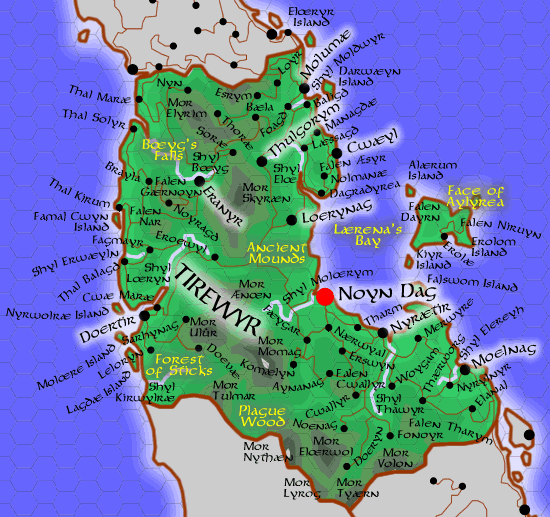Land of the Tirwyn
Tiréwyr is the ancestral land of the Tirwyn Horse Clans, though today it serves as the heartland for all the Ēōyn people. Shortly following the fall of the Old Empire, the Ēōyn assembled at the City of Nōyn Dag and agreed to create a confederacy of clans with the strength to expel the Dekàlyr from their ancient homeland. Unlike other defeated city-states within the Empire, it was determined that there were not enough soldiers in the Acèntyri armies to occupy the ruined island of Ildûn. A plan to inundate the island with Vulmùri immigrants and prisoners resulted in several massacres and lost ships.The Ēōyn Confederacy elected a body of Seven Kings (i.e., the Heptarchy), all descendant from ancient lines, which sat in a circular chamber within the City of Nōyn Dag and decided how best to win their homeland back. One of the elected kings would not be present as he and his people were eradicated with the loss of Ilûwyr. For all meetings of the Heptarchy, one throne remained empty in their memory.
Regions, Geographic
Tiréwyr is bounded by the Mar Dekàli to the east and west, the Ælyri provinces of Widrèwyr and Aðéwyr to the north and south respectively, and the Ildûni province of Ilûwyr to the southwest.
- Forest of Sticks
- Plague Wood.
Cities, Towns, and Villages
- City of Nōyn Dag
- Town of Cwæyl
- Town of Dōertir
- Town of Erányr
- Town of Loérynag
- Town of Moélnag
- Town of Nyrætir
- Town of Thulgòrym
- Village of Aynànag
- Village of Bæla
- Village of Balìgd
- Village of Brayla
- Village of Cwæ Maræ
- Village of Cwallyr
- Village of Dagràdyrea. A coastal village of saw-yards and lumber mills. The surrounding forests have been reduced to stumps. There is little lodging in the village, though visitors are invited to overnight in the work tents.
- Village of Dōéryn
- Village of Doévæ
- Village of Elánal
- Village of Eròewyl
- Village of Erolæ
- Village of Erswyn
- Village of Esrym
- Village of Fæygar
- Village of Fagmàyr
- Village of Foagd
- Village of Fonoyr
- Village of Komælyn
- Village of Læssagd
- Village of Lelòryn
- Village of Loyr
- Village of Manàgdæ
- Village of Merwyre
- Village of Nærwyal
- Village of Noénag
- Village of Nolmanæ. A hillside village on the east coast.
- Village of Noyragd
- Village of Nyn
- Village of Nyrylnyr
- Village of Sarhynag
- Village of Soræ
- Village of Thærworg
- Village of Thal Bàlagd. A beach-side village on the west coast.
- Village of Thal Kìrum. A beach-side village on the west coast.
- Village of Thal Màræ. A beach-side village on the west coast.
- Village of Thal Solyr. A beach-side village on the west coast.
- Village of Tharm
- Village of Thoræ
- Village of Woygam
Landmarks
- Boeyg’s Falls
- Face of Aylyrea. Every day, Ēōyn pilgrims arrive at the docks of Erolæ to undergo a long and strenuous hike. During the course of six days (three days each way) the pilgrims pass through forests and climb twisting stone staircases that culminate at a Stone Circle atop the island’s southernmost hilltop. Worn smooth by centuries of pilgrims, the ancient path is interrupted by small roundabouts that wrap around giant black stones that have been rubbed to a high polish. These seven prayer stones are believed to be all that remains of Dulrum Ælyra, destroyed almost 1800 years before by island’s conquerors. From the hilltop Stone Circle , the faithful are able to look down upon the island’s central valley. The Ēōyn believe that when the light hits the trees, streams, and outcroppings just right, the face of Ælyra can be seen.
- Kolkyrmuyn Inn. A modest wayside inn that manages the Ferry at Shyl Eloe.
People
History
Nomenclature: Tirewyr Dekàlic: Tiréwyr (place), Tiréwyri (pertaining to), Tiréwyn (resident), Tiréwyryr (people)
